
In today’s crowded advertising environment everyone is trying desperately to cut out their own slice of the market before their competitors have a chance to get to it. In an attempt to reach two rapidly expanding market segments – smartphone users and the younger generations – marketing professionals have started to adopt new tactics, one of the most interesting ones being advertising with emojis.

It’s starting to become more and more common to see billboards at train stations, bus stops, or airports with emojis displaying a coded message to the random passer by. It’s almost like a game of Pictionary, deciphering what exactly they mean, but that doesn’t reduce their effectiveness; in fact it’s probably contributed to their success.

Many companies have started advertising with emojis and their results have actually been quite interesting. In March of 2014 Burger King released an emoji keyboard to support the launch of their chicken fries. The keyboard featured 24 different emoji chicken fries to help users “express their feelings” about the chicken fries. The success of this campaign was widely spread and certainly helped the chicken fries take off once they returned.
An even simpler example of advertising with emojis was the American beer company Bud Light who advertised by using the pre-existing Apple emojis to make a US flag out of beer, fireworks, and US flags. The advertisement, shared via Twitter, netted the company nearly 150,000 re-tweets and 112,000 favorites as of today.

Probably one of the most complex examples of advertising with emojis was the campaign that Oreo implemented in 2014 where they created over 99 million customized emojis in 11 weeks. Because of emojis reliance on smartphones, Oreo chose to target the country with one of the largest smartphone demographics in the world, China.

Oreo decided to use software that allowed smartphone users to create their own emojis using pictures of their own faces. Once the emoji was created users had the ability to not only share but also interact with them by putting their emoji on bus stop shelters around town and controlling them. (Check out Mobile Marketer to read more about the Oreo emoji advertisement)
Advertising with emojis is strangely effective for a number of reasons and one of the primary ones is explained with the good old saying, ‘a picture is worth at thousand words.’ The words that emojis can portray can often hold power above literal words since they can convey the one-thing advertisements generally lack, emotion.
Sharing a small smiley face is much more effective at portraying your happiness than trying to explain it through text. Simply portraying emotion is far from emojis only benefit, it’s also much more concise in comparison with words. Using advertising with emojis is an effective way to reduce the length and complexity of your advertisements as well as appeal to the younger generations.
With increasing numbers of smartphone users, primarily in the younger generations, it makes sense to appeal to their shorthand when it comes to advertisements. Increasing your context in your messages, reducing their length, and appealing to the younger generations of smartphone users can give you a powerful advantage over your competitors. Advertising with emojis could be your key to unlocking a new demographic.





